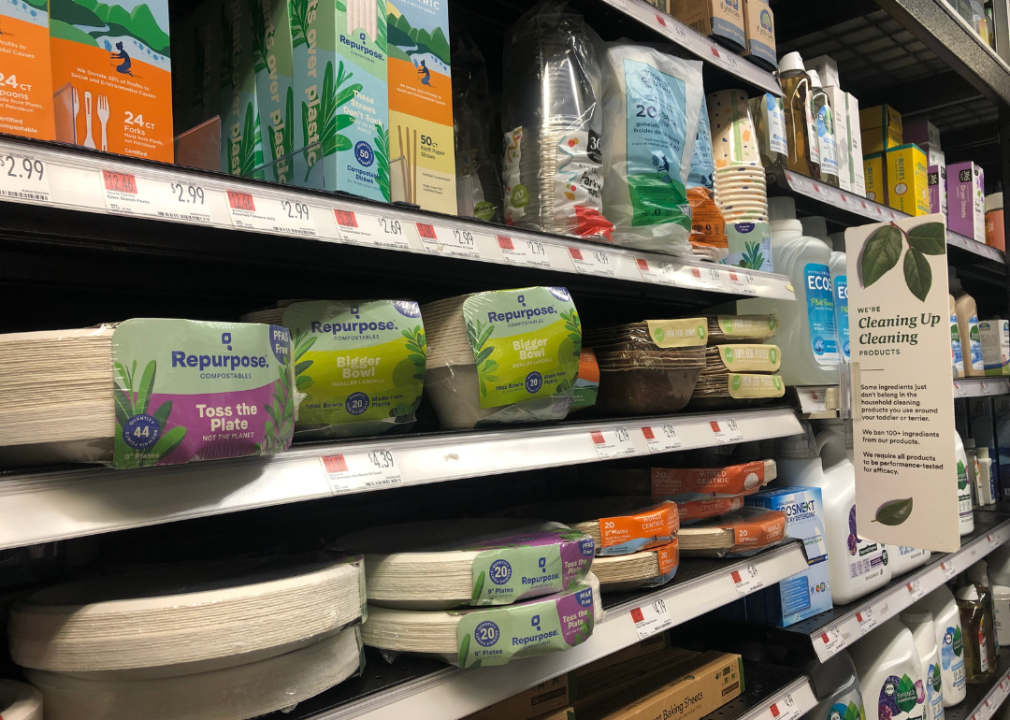Shoppers say they want eco-friendly products, so why aren't they buying them?

Emanuele Cremaschi // Getty Images
Shoppers say they want eco-friendly products, so why aren’t they buying them?
A person’s hand placing a wooden toy on a table of wooden toys for baby and infant-aged children.
On paper, being more sustainable and eco-friendly while shopping sounds great—so why don’t more people do it?
There is growing consumer consciousness about the environmental impact of where people choose to shop and the sustainability of the products they buy. According to McKinsey, over 60% of individuals surveyed in 2020 said they would be willing to pay more for a product that is packaged in an eco-friendly way. Since 2019, products marketed as being environmentally sustainable have seen a 28% growth in revenue compared to 20% for products with no such marketing, a 2023 McKinsey and NielsenIQ report found.
Much of this is thanks to the preferences and attitudes of Gen Z, who, on average, care more than their older counterparts about being informed shoppers. The younger generation also has more social justice and environmental awareness altogether.
Shoppers are willing to spend around 9.7% more on a product they know is sourced or manufactured sustainably, with 46% saying they would do so explicitly because they want to reduce their environmental footprint, according to a 2024 PwC report. Sustainable practices consumers look for from companies include production methods, packaging, and water conservation.
But despite the growing consciousness around being more environmentally responsible, consumer actions don’t always align with their values. In psychology, this is defined as the “say-do gap”: the phenomenon wherein people openly express concern and intention around an issue, but fail to take tangible action to make a change. According to the Harvard Business Review in 2019, most consumers (65%) say they want to buy from brands that promote sustainability, but only 1 in 4 follow through.
So why don’t people actually shop sustainably, despite how much they express a preference for eco-friendly products—and how can we close the gap?
The RealReal examined reports from the Harvard Business Review and other sources to explore why some shoppers want to buy sustainably but struggle to follow through. This lack of action isn’t due to a lack of caring—in many cases, it’s hard to know how to be a sustainable consumer and other factors are often outside of shoppers’ control. But the more people shop sustainably, the easier and more accessible that market will be for everyone—making it much easier for folks to buy aligned with their values.
![]()

Lindsey Nicholson/UCG/Universal Images Group // Getty Images
Barriers to sustainable shopping
Compostable plates, cups and utensils on the shelves at a store.
There are many obstacles preventing shoppers from upholding eco-friendly habits as much as they may want to—but not all of these barriers are necessarily real, or accurately understood.
Shopping sustainably simply isn’t convenient or accessible for many. Those who live in apartment buildings are 50% less likely to recycle, according to Ipsos. Reasons for this can vary from lack of space to buildings being excluded altogether because of recycling contamination issues.
Many believe that sustainable products are too expensive or of a lower quality. The former is often true, which does create a hurdle for many: The manufacturing processes and materials for sustainable products are pricey. For instance, organic cotton requires an intensive production process free of certain chemicals or pesticides; by definition, true eco-friendly products can’t be mass-produced, further upping their price tag. Using recycled materials for packaging, or obtaining an eco certification, can also be expensive.
However, although the narrative of eco-friendly products being more expensive is true, there is often more of an effort to use better quality materials that last longer than their noneco-friendly counterparts. This could end up saving consumers money in the long run: By paying more upfront, they can get more wear out of sustainable fashion, for instance.
There is also undeniable political rhetoric surrounding eco-friendly products—however, despite many Conservative politicians decrying sustainable products, members of all generations are increasingly choosing to prioritize shopping sustainably regardless of their political affiliation, according to research from NYU Stern Center for Sustainable Business. This finding shows a trend toward seeing sustainability as a nonpartisan subject everyone can benefit from, no matter where they lie on the political spectrum.
Some might think eco-friendly clothing, in particular, is not fashion-forward; after all, many of the top clothing retailers in the world partake in fast fashion. However, brands are increasingly being recognized as ‘cool’ and ‘trendy’ for supporting environmentally ethical practices, particularly as younger generations prioritize sustainability, as noted before.
Many increasingly popular online stores are taking advantage of this paradigm shift by offering secondhand shopping options that are not only fashionable, but also more affordable, like ThredUp or Poshmark.
Additionally, many legacy large-name brands are hopping on the sustainability movement and are gaining appreciation from loyal customers. Amazon’s Climate Pledge Friendly program partners with third-party certification bodies to make it easier for shoppers to identify eco-friendly products as they browse the website. H&M’s newly launched H&M Rewear program debuts a resale platform that allows the resale of all clothing brands—not just their own. Similarly, Patagonia’s Worn Wear program allows shoppers to trade in and buy used gear and clothing.
The federal government is also working to close this gap. The Environmental Protection Agency’s Safer Choice program is attempting to make sustainable shopping easier for consumers and companies alike. It includes a directory of certified products, a list of safer chemicals to look out for on labels, a “Safer Choice” label that products can earn to denote they are eco-friendly, and resources for manufacturers looking to adopt more sustainable practices.
Most of all, though, the biggest way shoppers can shift toward sustainable shopping is through their behaviors and attitudes amongst their peers and communities. Studies show that humans largely care what others think of their actions; the more shoppers make environmentally conscious shopping the norm, the more others will follow suit.
From an economic perspective, the more consumers shop eco-friendly, the more affordable and accessible these products will become, too: Sustainable products are currently more expensive because they are not in high demand. Once demand rises, production rates and prices can lower, making these products more accessible for all.
Story editing by Carren Jao. Additional editing by Kelly Glass. Copy editing by Kristen Wegrzyn.
This story originally appeared on The RealReal and was produced and
distributed in partnership with Stacker Studio.